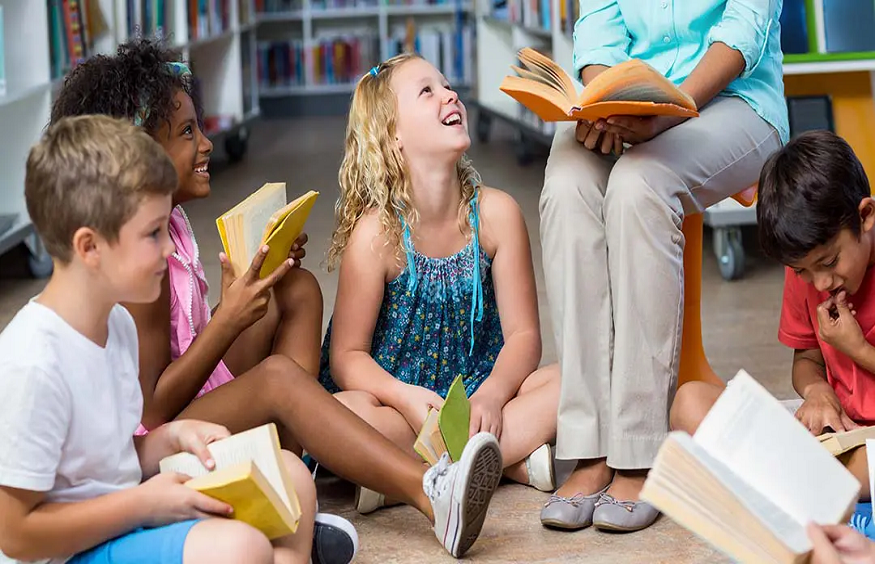In the journey of childhood development, learning to read is a crucial milestone. The ability to read opens up a world of imagination, knowledge, and opportunities for children.
As educators and parents, it is essential to employ interactive learning techniques that engage children actively in the process.
Interactive reading activities for kindergarten makes it not only fun and exciting but also enhances comprehension and retention.
In this article, we will explore various strategies and activities to help children start their reading journey.
Creating a Print-Rich Environment
One of the fundamental steps in teaching children to read is immersing them in a print-rich environment.
Surrounding children with words and written materials helps them develop an early appreciation for reading.
Consider creating a dedicated reading corner or bookshelf in their room, filled with age-appropriate books, magazines, and comics.
Display labels on everyday objects in their environment to familiarize them with print.
Read Aloud and Discuss
Guided reading for preschool where children read aloud to children is a powerful way to introduce them to the world of stories, characters, and concepts.
Choose books with engaging plots, colorful illustrations, and age-appropriate vocabulary. As you read, use different voices for characters and pause to ask questions or encourage predictions.
Encourage children to ask questions, express their thoughts, and make connections to their own experiences. Discussing the story promotes critical thinking and comprehension skills.
Phonics and Phonemic Awareness
Phonics and phonemic awareness lay the foundation for reading. Phonics involves teaching the relationship between sounds and letters, while phonemic awareness focuses on recognizing individual sounds within words.
Engage children in playful activities that help them identify and manipulate sounds, such as rhyming games, sound matching, and blending exercises.
Introduce letter-sound correspondence gradually, starting with simple words and gradually progressing to more complex ones.
Sight Words and Word Recognition
Sight words are commonly used words that children should recognize instantly without having to decode them.
Introduce sight words through interactive games and flashcards. Make the learning process enjoyable by incorporating movements or actions to accompany each word.
Engaging children in word recognition activities, such as word hunts or word walls, further reinforces their reading skills.
Interactive Technology and Educational Apps
Technology can play a beneficial role in teaching children how to read. Interactive educational apps and digital platforms provide engaging and personalized learning experiences.
Look for apps that offer interactive stories, phonics activities, and word-building games. However, it is essential to strike a balance and ensure that screen time is limited and used purposefully.
Multi-Sensory Approaches
Children learn in different ways, and employing multi-sensory approaches caters to their individual strengths.
Incorporate activities that involve sight, sound, touch, and movement to enhance learning. For example, creating letter-shaped art with craft materials, or using magnetic letters for word building.
By engaging multiple senses, children develop a deeper understanding of language and reading concepts.
Real-World Reading Experiences
Connecting reading to real-life experiences helps children see the practical value of reading skills. Encourage them to read menus, signs, grocery lists, or instructions while engaged in everyday activities.
Take regular trips to the library or bookstore, allowing children to select their books of interest.
These experiences foster a love for reading and expand their exposure to different genres and topics.
Storytelling and Role-Playing
Storytelling and role-playing activities provide children with opportunities to engage actively in the reading process.
Encourage children to create their stories, using their imagination and creativity. This can be done through drawing pictures, writing sentences, or even acting out their stories.
Role-playing allows children to step into the shoes of characters, fostering empathy and a deeper understanding of the narrative.
These activities help develop language skills, vocabulary, and comprehension while making reading a dynamic and interactive experience.
Reading Buddies and Book Clubs
Pairing children with reading buddies or organizing book clubs can enhance their reading journey. Reading buddies can be older siblings, friends, or family members who can read together and discuss books.
This not only promotes bonding but also provides a supportive environment for learning. Book clubs, whether in-person or virtual, allow children to share their thoughts and opinions on books, exchange recommendations, and develop their analytical skills.
Word Games and Puzzles
Word games and puzzles are engaging activities that reinforce reading skills while providing a playful learning experience.
Crossword puzzles, word searches, and word scrambles can be customized to incorporate vocabulary and sight words relevant to a child’s reading level.
These games challenge children to think critically, expand their vocabulary, and improve their spelling and word recognition abilities.
Reading Apps with Tracking Features
Using reading apps that offer tracking features can motivate children to read regularly and monitor their progress.
These apps provide personalized reading class for toddlers and has recommendations based on the child’s reading level and interests, making the reading experience more enjoyable and tailored to their needs.
Progress tracking allows children to see their achievements, set goals, and receive rewards, fostering a sense of accomplishment and motivation to continue reading.
Collaborative Storytelling and Writing
Engaging children in collaborative storytelling and writing activities sparks their creativity and improves their reading and writing skills simultaneously.
Encourage children to work together to create a story, taking turns adding sentences or paragraphs. This collaborative process strengthens their understanding of narrative structure, character development, and language usage.
Additionally, provide opportunities for children to write their stories, whether it’s a simple sentence or a short paragraph.
This helps them apply their reading skills to their writing and reinforces their comprehension and language abilities.
Incorporating Multicultural Literature
Introducing children to literature from diverse cultures and backgrounds broadens their horizons and encourages empathy and understanding.
Incorporate books and stories that showcase characters and settings from various cultures and traditions.
This not only exposes children to different perspectives but also promotes inclusivity and fosters a sense of curiosity and appreciation for the world around them.
Conclusion
Interactive learning is a powerful tool in teaching children how to read. By creating a print-rich environment, reading aloud, introducing phonics and sight words, incorporating technology, and utilizing multi-sensory approaches, children can develop strong reading skills while enjoying the process.
Remember to tailor activities to suit the child’s age and developmental stage, allowing for gradual progression.
Encourage a love for reading by making it a fun, interactive, and shared experience. By nurturing their reading skills, we empower children to explore the world, unlock their potential, and become lifelong learners.

